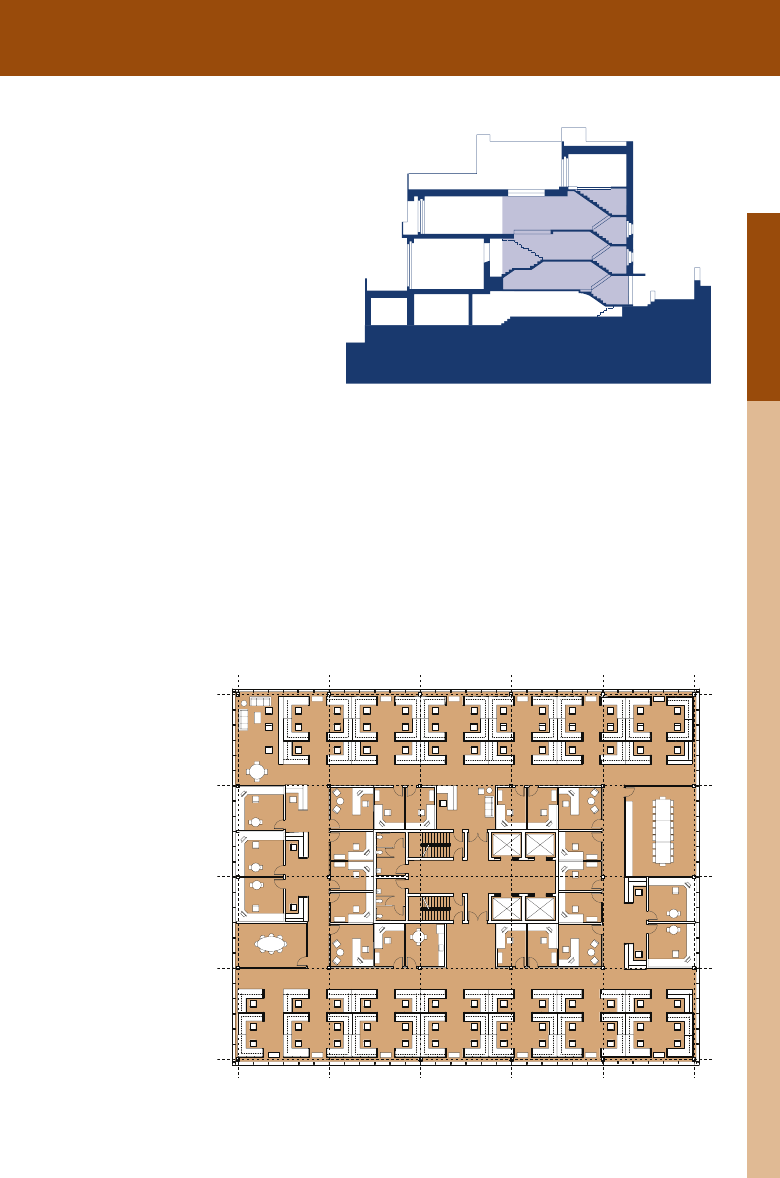
06
Job:02-30056 Title: RP-Interior Design Reference and Specification
#175 Dtp:216 Page:89
Job:02-30056 Title: RP-Interior Design Reference and Specification
#175 Dtp:216 Page:88
(RAY)
084-091_30056.indd 89 3/4/13 7:32 PM
Text
89
Sequencing Spaces
should be greater than that of the powder room or a coat closet, for example. Opportunities for
taller spaces. Le Corbusier organized houses around double-height living rooms at every stage
tial-level stairs rather than the full-oor stairs of conventional house designs offers numerous
levels to shift, creating rooms with a mix of ceiling heights. As a result, the interiors of Loos’s
houses resemble a terraced landscape. In houses with these complex sectional relationships,
Adolf Loos, Müller House
COMPOSING AN OFFICE SPACE IN PLAN
Since the modern ofce is designed for a preexisting at-oor-plate ofce building, there are
very few opportunities for creativity in the section. Rather, it is the logic of the plan module that
generates design possibilities. Most modern ofce buildings have been designed on a 5-foot
(1.5-meter) module that controls both the location of the structural grid and the mullions on
the exterior window wall. This module works with the dimensional module of the American
systems furniture industry, including manufacturers such as Steelcase and Herman Miller.
This 5-foot grid means that perimeter ofces are typically 10 or 15 feet (3 or 4.6 meters) wide—
occasionally wider for senior executives. It also governs other rooms located along the perim-
eter walls, such as conference rooms and reception areas.
A series of intimate, terraced spaces along
the sides of a triple-height space, exempli-
ed in the section of the Müller House, is
another strategy for varying spatial heights.
Job:02-30056 Title: RP-Interior Design Reference and Specification
#175 Dtp:216 Page:89
Job:02-30056 Title: RP-Interior Design Reference and Specification
#175 Dtp:216 Page:88
(RAY)
084-091_30056.indd 89 3/4/13 7:32 PM

06
Job:02-30056 Title: RP-Interior Design Reference and Specification
#175 Dtp:216 Page:90
(RAY)
084-091_30056.indd 90 3/4/13 7:32 PM
Text
9 0
THE INTERIOR DESIGN REFERENCE + SPECIFICATION BOOK
Open Plan
In an open plan layout, open workstations ll the entire space. Since natural light can pen-
etrate further into the space, buildings that are designed to accommodate an open plan have
deeper oor plates. This is a standard layout for the back-ofce functions of nancial institu-
tions and insurance companies.
Open Workstations at Window Wall, Private Offices in Center
Related to the open plan above, this layout places enclosed ofces on the inside of the plan,
typically against the core. Private ofces in this plan conguration have mostly glass walls to
benet from the natural light in the open ofce area.
Typical Ofce Layouts
Private Ofce at Window Wall
This layout is typically organized in three layers of functions; starting with a zone of private
ofces at the window wall, followed by a zone of circulation, then a zone of back-to-back par-
tial-height cubicles for assistants, and a second zone of circulation against the building core.
Natural light typically reaches the middle of the plan through clearstory windows in the wall
that separates the private ofces from the rest of the ofce space. This layout results in
a conventional dimension from building core to window wall of approximately 45 feet (13.7
meters), which has become the ideal industry standard for the minimum width of American
ofce buildings.
zone 1
Private Ofces
zone 3
Cubicles/Workstations
zone 2
Circulation
zone 4
Building core/Circulation
Job:02-30056 Title: RP-Interior Design Reference and Specification
#175 Dtp:216 Page:90
(RAY)
084-091_30056.indd 90 3/4/13 7:32 PM

06
Job:02-30056 Title: RP-Interior Design Reference and Specification
#175 Dtp:216 Page:91
Job:02-30056 Title: RP-Interior Design Reference and Specification
#175 Dtp:216 Page:90
(RAY)
084-091_30056.indd 91 3/4/13 7:32 PM
Text
91
Sequencing Spaces
Open Plan
In an open plan layout, open workstations ll the entire space. Since natural light can pen-
etrate further into the space, buildings that are designed to accommodate an open plan have
deeper oor plates. This is a standard layout for the back-ofce functions of nancial institu-
tions and insurance companies.
Open Workstations at Window Wall, Private Offices in Center
Related to the open plan above, this layout places enclosed ofces on the inside of the plan,
typically against the core. Private ofces in this plan conguration have mostly glass walls to
benet from the natural light in the open ofce area.
ofces at the window wall, followed by a zone of circulation, then a zone of back-to-back par-
tial-height cubicles for assistants, and a second zone of circulation against the building core.
Job:02-30056 Title: RP-Interior Design Reference and Specification
#175 Dtp:216 Page:91
Job:02-30056 Title: RP-Interior Design Reference and Specification
#175 Dtp:216 Page:90
(RAY)
084-091_30056.indd 91 3/4/13 7:32 PM
..................Content has been hidden....................
You can't read the all page of ebook, please click here login for view all page.
